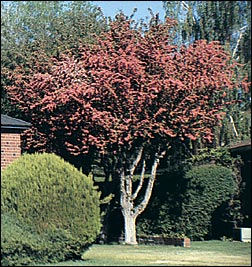
Hawthorn trees are good for streets, but are a maintenance nightmare for anyone trying to maintain a structured tree. They are dense, twiggy and usually very thorny as well. One of their best uses given these tendencies is as a hedge, screen or barrier planting. All bloom in April-May and produce clusters of fruit in the fall. All are prone to pests (scale, borers and spider mites) and fire blight. Plant in full sun, well-drained soil and water deeply once every 10-14 days. Attracts bees and birds. Not temperature sensitive and does not need protection, but is disease prone.
- C. crus-galli (Cockspur Hawthorn) 35 ft. tall by 25 ft. wide; white flowers in May; red fruit; orange-red fall color
- C. laevigata Pauls Scarlet 20 ft. tall by 20 ft. wide; double red flowers in May; scarlet fruit
- C. lavallei (Lavalle Hawthorn) 20 ft. tall by 20 ft. wide; white flowers in May; red fruit; bronze-red fall color
- C. mollis (Downy Hawthorn) 30 ft. tall by 30 ft. wide; white flowers in May; red fall color
